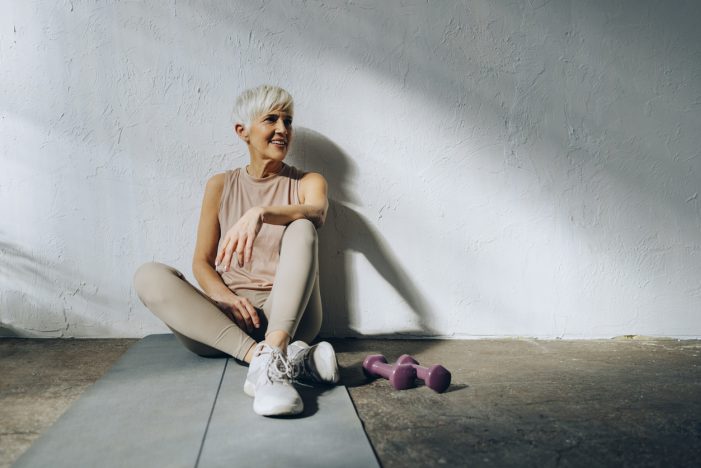Physical Exercise Significantly Lowers Risks for COVID-19 Complications

A new study published last week in the American Journal of Preventive Medicine found that exercise of any amount had a protective effect on risk of hospitalization and death from infection with SARS-CoV-2 and symptoms of COVID-19.1 This retrospective cohort study follows 25 previous studies that also reported strong associations between mortality and hospitalization, and physical inactivity.2
Using the records of patients enrolled in Kaiser Permanente Southern California, researchers examined 194,191 adults who had a positive COVID-19 test between January 2020 and May 2021 and had self-reported their exercise patterns at least three times in the two years before contracting the SARS-CoV-2 virus using the Exercise Vital Sign (EVS) tool. Patients were categorized as: always inactive (all assessments 10 minutes/week or less); mostly inactive (median of 0−60 minutes per week); some activity (median of 60−150 minutes per week); consistently active (median greater than 150 minutes per week); and always active (all assessments greater than 150 minutes per week). Adverse outcomes within 90 days after a COVID diagnosis were identified as hospitalization, deterioration event, or death.
Over half of the participants had a body mass index (BMI) of 30 or above, 21 percent had a diagnosis of hypertension, and over nine percent (nine percent) were diagnosed with cardiovascular disease.
More Activity Results in Better COVID Outcomes
This study showed stepwise higher odds of developing SARS-COV-2 complications and adverse COVID outcomes with each increment in physical inactivity, and a consistent dose‒response association across physical activity categories. The strongest association was found between the “always active” with the “always inactive” categories. Patients in the “always inactive” category had 91 percent higher odds of hospitalization, 139 percent higher odds of a “deteriorating event” and 291 percent higher odds of death than patients in the “always active” category. Results were generally consistent across sex, race and ethnicity, age, and BMI categories.
For patients with hypertension or cardiovascular disease, even the “some activity” category had higher odds of death than the “always active” category. This data indicates that if a person with chronic disease was infected with SARS-CoV-2, the odds of hospitalization, inpatient deterioration event, and death were lowered among those who were engaged in some physical activity before a COVID diagnosis, compared with those in the “always inactive” category.3
Why This Study is Important
The relationship between physical activity and outcomes from SARS-CoV-2 infections for those with chronic conditions and across other sociodemographic factors had not been widely studied. This study shows that the obvious benefits of physical activity for COVID outcomes applies similarly across age, sex, race, ethnic population and chronic conditions subgroups. Knowledge about subgroup effects could help to inform the development of targeted physical activity recommendations.
“Regardless of demographic factors and common chronic health conditions, results suggest that reducing physical inactivity may be one pathway to lowering the odds of adverse COVID outcomes. The benefits of reducing physical inactivity should lead to its recommendation as an additional coronavirus pandemic control strategy for all, regardless of demographics or chronic disease status,” the study authors conclude.4
Although physical activity has similar benefits for all racial and ethnic groups, it is more difficult to be physically active for people of low socioeconomic status (who are disproportionately non-White), who have fewer financial resources, who are more likely to live in unsafe neighborhoods, and who may have limited time for physical activity owing to multiple jobs. The study authors concluded:
Public health leaders should take the results as further impetus to develop and implement equitable promotional strategies and opportunities for physical activity for all people.
Dangerous Sedentary Lifestyle at All-Time High
A Mayo Clinic analysis of 13 studies concluded that sitting time and activity levels found in those who sat for more than eight hours a day with no physical activity had a risk of dying similar to the risks of dying posed by obesity and smoking.5 That is terrible news given that the average American adult sits more than at any other time in history.
Sedentary jobs have increased 83 percent since 1950 according to the American Heart Association. Twenty-five percent of Americans spend more than eight hours a day sitting, and according to a United Nations report, the U.S. ranks 143 out of 168 countries surveyed in terms of physical fitness—40 percent of Americans do not meet the minimum suggested guidelines for physical activity of 2.5 hours of moderate activity weekly.6
Sedentary behavior increases the risk of some types of cancer by up to 66 percent, cardiovascular disease by 147 percent, diabetes risk by 112 percent), and depression by 47 percent). A 2010 study reported that people who spent more than six hours per day sitting with low levels of physical activity have a 71 percent increase in mortality rate.
“We are sitting ourselves to death”
Alarmingly, a 2011 study showed that even with four to seven hours of moderate to vigorous exercise weekly, sitting for five to six hours a day still increases mortality by 50 percent. “We are sitting ourselves to death,” warned James Levine, MD, director of the Mayo Clinic.7 More hopefully, a 2015 study by the University of Utah School of Medicine found that moving just two minutes every hour can decrease premature death risks by 33 percent.8
If you would like to receive an e-mail notice of the most recent articles published in The Vaccine Reaction each week, click here.
Click here to view References:
No comments:
Post a Comment